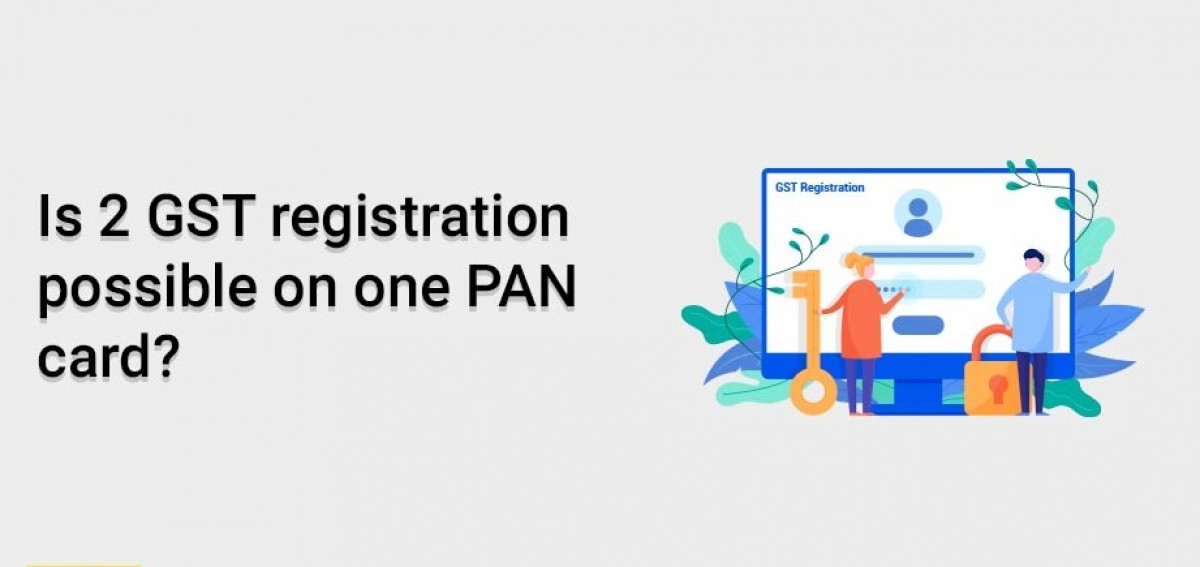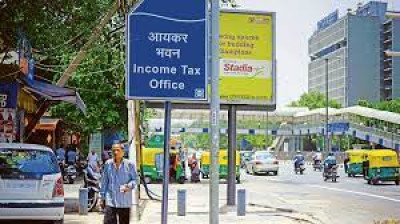In India, any business entity with an annual revenue of more than INR 20,00,000/- is obliged to register under the GST laws. GST registration entails getting a 15-digit unique identification number, GSTIN, which is encrypted with the applicant's PAN (Permanent Account Number) and state code.
Because the government has made the allotted PAN mandatory for applying for GST registration, it has also given leading enterprise concepts the option to extend their business with two or more state divisions, each with its own unique GST number registered with a single PAN.
With a single PAN, you can register for two GST registrations in one state or union territory. GST, or Goods and Services Tax, is one of India's most revolutionizing tax regimes, with the motto "One Nation, One Tax." GST, which is an indirect tax, is linked to the PAN, which serves as the basis for direct taxes. Let's look at the fundamentals of GST registration:
PROVISIONS IN THE GST LAW FOR MULTIPLE GST REGISTRATIONS:
Section 25(1) of the CGST Act, 2017 states that every person must register for GST in each state or union territory where he or she is obliged to register.
This implies that if you conduct your business from two different locations, you'll need to register for GST for each one separately.
A person operating a manufacturing business in Kolkata with a subsidiary business office in Delhi, for example, must obtain a separate GST registration for each state - one in Kolkata and one in Delhi. In addition, the same PAN can be used to register in both states.
According to Section -25(1) of the CGST Act, 2017, anyone who is obliged to register for GST under this Act must apply for registration in each state or union territory in which he is obliged to register
For example, if a person doing business in two different states, such as Delhi and Mumbai, is obliged to register under this act, the person must apply for registration in each of those states separately, and GST registration will be granted accordingly. Because GST registration is based on a person's PAN number, GST registration will be approved in each of these states under the same PAN number.
Section 25(2) of the CGST Act, 2017 provides that a person conducting business in more than one business vertical in a single state or union territory may be given a separate GST registration for each unique business vertical, subject to certain restrictions and requirements.
According to Section 25(2) of the CGST Act 2017, a person wanting registration under this Act in a State or Union territory shall be given a single registration:
Provided, however, that a person with numerous business verticals in a State or Union territory may be given a separate registration for each business vertical, subject to such conditions as may be prescribed.
The original proviso to Section 25(2) has been replaced with- Provided that a person having various places of business in a State or Union territory may be given a distinct registration for each such place of business, subject to such conditions as may be prescribed by the CGST Amendment Act 2018
Normally, under this act, a person can only obtain a single GST registration in a state or union territory.
As per Sec 25 of the GST Act, a person carrying on multiple business verticals in a state or union territory may be issued a separate GST registration for each of those business verticals if the conditions are fulfilled (2)
It is obvious from the above that a person can register for several GST registrations in a state or union territory using the same PAN.
Definition of Business Vertical:
Business Vertical -Under Section 2 (18) of the CGST Act, 2017 - A distinct element of an enterprise that is involved in the supply of individual goods or services or a collection of related goods or services and is subject to risks and returns that are distinct from those of the other business verticals is referred to as a "business vertical."
Explanation-Factors to examine in assessing whether goods or services are connected for the purposes of this section include:
(a) the nature of the goods or services
(b) the nature of the production processes
(c) the kind or class of the goods or services' consumers
d) the methods for distributing goods or providing services; and
e) the regulatory environment (when applicable), such as banking, insurance, or public utilities
A "business vertical" is a distinct element of an enterprise that is involved in the supply of individual goods or services, or a group of linked goods or services, and is exposed to risks and returns that are distinct from the other business verticals.
This means that within the same state or union territory, two distinct businesses can function with multiple GST registrations using the same applicant's PAN. Section 25 stipulates that these verticals must adhere to specific provisions and rules.
The following provisions should be considered for new vertical registrations under GST that are not already registered verticals, as explained in the preceding section:
(a) the nature of the goods or services
(b) the nature of the production processes
(c) the kind or class of the goods or services' consumers
(d) the methods for distributing goods or providing services; and
(e) the regulatory environment (when applicable), such as banking, insurance, or public utilities
CGST Rules 2017, Rule 11 – Within the same State or Union Territory, the law also establishes guidelines for trying to obtain separate GST registrations for different business verticals. To obtain registration for a new vertical, Rule 11 (1) states that:
- Such a person must have more than one business verticals in order to meet the definition set forth in section 2 (18) of the act.
A taxable person's vertical choice will not be registered under section 10 (composition levy) if the same person's other business vertical is already registered.
Section 9 - All separately registered verticals of such person must pay tax under the act on supplies of goods or services, or both, made to other registered business verticals of such person, and must provide an invoice for the same.
Note: If a person's business vertical becomes ineligible to pay tax under section 10, all of the person's other business verticals become ineligible to pay GST.
Rule 8(1) of the CGST Act 2017 states that person with a business unit registered in a Special Economic Zone (SEZ) or who is a SEZ developer must register a separate application as a vertical to be recognised outside of the SEZ for separate GST registration.
As a result, from February 1, 2019, taxpayers will have the option of acquiring registration for each individual place of business within a given state or union territory, even if the aforementioned multiple business locations are not in distinct business verticals.
Who should use Form ITC-02A and what is it? Within 30 days after getting the new registration, the principal place of business (transferor) can transfer any unutilized balance of input tax credit to a new branch (transferee) in the ratio of the value of assets. Regardless of whether or not ITC has been claimed on assets, their worth must be examined. The transfer of ITC is accomplished by the transferor completing Form GST ITC-02A.
What is the purpose of GST Form ITC-02A : ITC transfer follows a similar pattern to ISD distribution, but within the same state/Union Territory and based on asset distribution.
It is probable that the head office purchases capital goods, inputs, or input services for a new branch before it is established inside the same state (principal place of business). The principal place of business would have already claimed ITC on the capital goods, inputs, or input services in this case.
Such ITC claims should preferably belong to the branch because it consumes or utilises the capital goods, input services, or inputs . To transfer such unutilized ITC to the newly constituted branch, use Form GST ITC-02A.
However, under Rule 11 of the CGST Rules 2017, there are several conditions for acquiring registration for several locations of business in a state or union territory:
- There should be uniformity in deciding whether to use a composition scheme at all places of business or none at all. It has also been stated that if any registered person's place of business that has been given a separate registration becomes ineligible to pay tax under section 10, all of the said person's other registered places of business would likewise become ineligible to pay tax under that section.
- GST must be charged on all supplies made between several locations with distinct GSTINs, and a tax invoice or bill of supply must be issued.
Transfer of credit on obtaining separate registration for multiple places of business within a State or Union territory
When a taxpayer obtains separate registration for multiple place of business within a state or union territory, Rule 41A of the CGST Rules 2017 specifies the procedure for transferring input tax credit. Following are the steps to be taken:
1. This rule applies to a registered person who has obtained separate registration for multiple places of business within a state or union territory and plans to transfer the unutilized input tax credit in his electronic credit ledger to any or all of the newly registered places of business, either entirely or partially.
2. Within 30 days of obtaining separate registrations, the registered person must submit Form ITC-02A. The Form ITC-02A was previously unavailable on the portal, but it has now been made available, allowing taxpayers to conveniently transfer their unutilized input tax credits from electronic credit ledgers to their newly registered place of business. Previously, because the form was not functioning, taxpayers used to transfer stock by issuing tax invoices to newly registered persons, which caused extra hassles.
3. The newly registered entities will receive input tax credits in proportion to the value of assets owned at the time of registration.
Note that the term "value of assets" refers to the whole value of a business 's assets whether or not an input tax credit has been claimed.
4. On the common portal, the newly registered person (transferee) accepts the details provided by the registered person (transferor), and the unutilized input tax credit mentioned in FORM GST ITC-02A is credited to his electronic credit ledger.
GST Registration Process: The GST Multiple Registration procedure is completed online using a portal. The Central Government of India maintains and operates this portal. The government is required to appoint GST Suvidha Providers, or GSPs. This person has been assigned to assist with the registration process. The registration procedure is as follows, depending on the information by the GST portal:
• The applicant must submit Part A of Form GST REG – 01 via the GSTN site or at a Facilitation Center. The applicant must provide his or her PAN, cell phone number, and email address below.
• After that, the PAN, mobile number, and email address are verified on the GST portal and via the OTP. Following this verification, the applicant is given a reference number, as well as an acknowledgement in the form GST REG-02.
• In Part B of FORM GST REG-01, the application reference number must be specified. This form must be filed once all other required information has been completed and the required documents have been attached.
·If any additional information is required, FORM GST REG-03 is given.
· Within 7 working days from the date of receipt of the above-mentioned form, the applicant must submit FORM GST REG-04 in response to the information requested.
· By filling the above-mentioned documents and providing all essential information in Form GST REG-01 or Form GST REG-04, the applicant can obtain a certificate of registration in Form GST REG –06 for the place of business and each additional place of business. For each business type, a person with multiple businesses in a state could make a separate application for GST registration in Form GST REG-01.
·The registration application can be rejected by Form GST REG-05 if the details given are incorrect. Candidates who are required to deduct or collect TDS must apply for GST registration using Form GST REG – 7. The officer can revoke and announce the cancellation of registration if he is no longer obligated to deduct or collect tax at source.
Conclusion: While GST registration is PAN-based and state-specific, a person can obtain many GSTINs in a single state or union territory if they conduct various business verticals or have several branches inside the state or union territory. Only if a person conducts business in two or more States or Union Territories, or if the registration procedure is carried out as various business verticals in a single State or Union Territory, may a person receive more one GSTINs.
Points to be noted in case of obtaining more than one GST registration
- The GST has a number of distinct provisions for Multiple Registration. Businesses with an aggregated turnover of more than INR 40 or 20 lakhs in the event of supply of goods and INR 20 or 10 lakhs in the case of supply of services are required to register as a regular taxable person under the GST Act.
- The business must fulfil the requirements of the Business Vertical as established by Section 2 of the Act (18)
- A business vertical cannot get a composition scheme if one of its other business verticals has become ineligible to pay tax under composition.
- On the supply of goods or services, or both, by a registered business vertical to another registered business vertical of such person, a tax invoice must be issued and tax must be paid under this act.
- If a taxpayer conducts multiple locations within a state or union territory, each location can be registered separately under the GST. In addition, the ITC-02A can be used to transfer the unutilized input tax credit to new registered persons.






